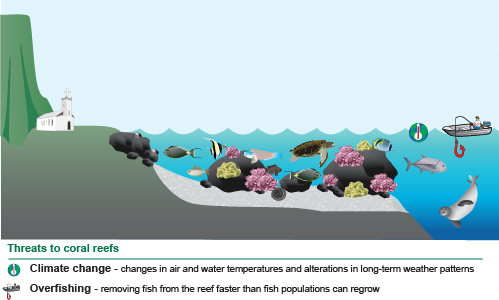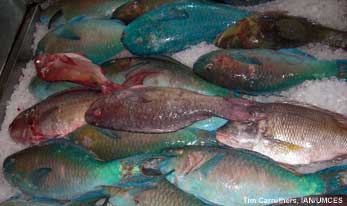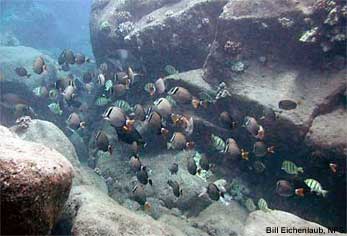Climate change and overfishing threaten the coral reef communities at Kalaupapa National Historical Park
 Despite its isolation, Kalaupapa National Historical Park is impacted by human activities such as climate change and overfishing.
Despite its isolation, Kalaupapa National Historical Park is impacted by human activities such as climate change and overfishing.
On coral reefs, the impacts of climate change magnify pressure from overfishing (Mimura et al. 2007). For example, fish populations already suffering from the effects of overfishing, may have to deal with the pressure of altered ocean chemistry due to increased carbon dioxide in the atmosphere. This altered ocean chemistry results in ocean acidification which damages corals, and reduces the habitat for reef fish (Mimura et al. 2007). Without coral habitat, some fish and culturally significant organisms such as ʻopihi (limpets) may no longer exist Kalaupapa National Historical Park.
Increased water temperatures due to climate change will have additional impacts on coral reefs such as coral bleaching. Coral bleaching is the phenomenon where corals expel their beneficial algae and become white in color. Though few coral bleaching events have occurred here (NPS 2009), increasing water temperatures may lead to more frequent bleaching events in Kalaupapa National Historical Park. In addition, warmer waters generate more intense storms and typhoons in short time periods. These episodic events will be more dramatic given predictions of overall reduced rainfall in Hawaii (Global Climate Change Impacts in the U.S. 2009). With continued warming, storms will have higher winds and rain will be more intense (Global Climate Change Impacts in the U.S. 2009). These intense storms and typhoons may pound the coast of Kalaupapa peninsula and have the potential to damage coral reefs.
With careful monitoring and research, scientists at Kalaupapa National Historical Park will be able to observe the changes in coral reef communities brought on by climate change. This information will assist in developing plans to protect the natural and cultural resources of the park.
Together park scientists and community members work to educate visitors and prevent overfishing at Kalaupapa National Historical Park. Also, the careful monitoring of fish populations in the park help to guide park and state fisheries management plans that aim to increase the number of large adult fish on coral reefs.
More ways to explore coral reefs at Kalaupapa National Historical Park
Kalaupapa National Historical Park WebsiteCoral reefs at Kalaupapa
Coral reef studies and products
The Legacy of Kalaupapa
Climate change monitoring briefs
Coral Reefs in U.S. National Parks

